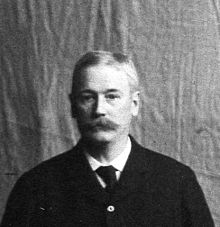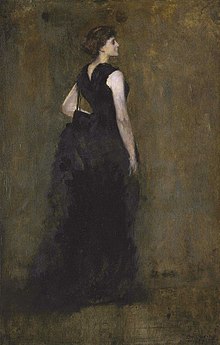Thomas Dewing
Thomas Wilmer Dewing (born May 4, 1851 in Newton Lower Falls , Massachusetts , † November 5, 1938 ) was an American painter at the turn of the 20th century. Dewing is assigned to the tonalists . He was married to the painter Maria Oakey Dewing , belonged to the Ten American Painters and was sponsored by Charles Freer, among others.
Childhood and youth
Dewing's parents Paul and Sophronia Durant Dewing married in Newton in 1834 . At that time, his father was the operator of a paper mill, but he later lost interest in it and switched to a number of less lucrative jobs in different locations. Wilmer Dewing was the fifth and last child. Like his brothers Hamlet and Fulton, the adult Dewing changed his romantic first name to a more contemporary name, so that he became known as Thomas Dewing.
The family lived in Boston at the time of Dewing's birth . Soon the family was dependent on the income of the firstborn son. In 1863, Dewing's father died after a drinking bout. He has not been mentioned in the family since then.
The young Dewing is described as handsome, had a talent for drawing and playing the violin, amassed a collection of bird nests and butterflies, and showed an interest in acting. His brother Charles collected first editions of books like The Autobiography of Benjamin Robert Haydon , which would become one of Dewing's favorite books.
After the death of his father, Dewing worked as a lithographer under Dominique Fabronius. Although he used the medium for 10 years or more, only a few lithographs by Dewing have survived. He was a member of the New York American Society of Painters on Stone . In 1868, however, it was listed as a taxidermist in the Boston address book . It was not until 1872 that it appeared under the name of artist . Two years later he had set up in a studio.
Traineeship as a painter
The chalk drawings Portrait of Eliza Williams Stone Paine Dewing and Portrait of Walt Whitman brought Dewing into contact with his first known patrons, Susan and Peter Gansevoort. They invited him to Albany in 1875, where he did various commissioned work to finance his studies abroad. In July 1876 Dewing left for Paris, where he became the first American to study at the Académie Julian . His teachers included Gustave-Rudolphe Boulanger and Jules-Joseph Lefèbvre. A Young Sorcerer , an act , was also created here .
Like other Americans he met in Paris, such as Julian Alden Weir , William Merritt Chase, and William Sartain , he ignored the Impressionists.
In 1877, when he ran out of money, he returned to the USA.
Working life
Dewing settled back in Boston and got an assistant job at the new art school of the Museum of Fine Arts , set up in a studio and exhibited various works. This earned him the interest of Robert Swain Gifford and George Fuller .
Gifford persuaded Dewing to take part in the first exhibition of the later Society of American Artists , where A Musician was shown.
In 1879 he painted Morning , an enigmatic work that received much criticism at its exhibition in Boston. Dewing then had the picture exhibited in New York, where there was also positive criticism. In May 1880 he was elected a member of the Society of American Artists , which solidified his decision to move to New York.
From October 1880 on, Dewing lived in New York for 50 years. In New York, Dewing met R. Swain Gifford and Dwight Tryon , who became a lifelong friend. During the first days of his stay in New York, he visited the famous painter Maria Richards Oakey with a letter of recommendation . Shortly afterwards, on Christmas 1880, Dewing and Oakey, who was six years older than him, announced their engagement, and the wedding followed on April 18, 1881.
Oakey gave Dewing access to the Gilder Circle. Richard Watson Gilder was the editor of Scribner's Magazine , which later became Century Magazine . He and his wife, Helena de Kay, a friend of Oakeys, have hosted a circle of actors, artists, musicians, writers, philanthropists, millionaires and philosophers.
James McNeill Whistler's works, exhibited in New York in 1881 , became a new influence in Dewing's artistic development. In the spring of 1883, Dewing's first work based on English aesthetic influences was created: A Prelude . It took pride of place in the Society of American Painters exhibit and was sold for $ 2,000 in no time.
In June 1883, the Dewings set out for Europe. One of the reasons for the trip was to acquire reproductions of masterpieces for the Art Students League , where Dewing taught. In Bayreuth they saw a performance of Parsifal in honor of the recently deceased Wagner. In London they saw works by Burne-Jones, which Dewing was not enthusiastic about.
In 1887 Dewing painted The Days , in whose creation his wife also played a major role. The painting earned him the Clarke Prize and a year later full membership of the National Academy of Design .
During the 1880s, the architect Stanford White Dewing brokered many of his commissions.
In the second half of the 1880s, Dewing then turned to the topic for which he is famous today: Lady with a Lute and Lady in Yellow are two examples of the contemporary female figure .
Now John Gellatly and his wife Edith became Dewings' supporters and admirers. Compared to Sadakichi Hartmann , Gellatly described Dewing as the greatest living artist. Hartmann reported that Dewing depicted the purity of womanhood in his paintings. In 1888 Dewing was elected a member ( NA ) of the National Academy of Design .
In 1890 Dewing met Charles Lang Freer , who became another collector and patron of his art. From then on, the Dewings spent the summers in Cornish , New Hampshire , where they also became founding members of an artists' colony .
In October 1894, the Dewings set out on another trip to Europe. London proved unsuccessful, apart from being able to work with Whistler. In Paris, however, there was the opportunity to exhibit pictures. There was also the opportunity to visit Giverny . In July 1895 the family returned to New York.
The 1906 murder of Stanford White horrified Dewing and made him more financially dependent on Freer.
Dewing became a founding member of the Ten American Painters , a group of painters other than Impressionists who split off from the Society of American Artists in 1897. In 1908 he was elected to the American Academy of Arts and Letters .
At the time of his death, after a long illness, Dewing was almost forgotten.
Painting style
He was best known for his tonalist paintings, a sub-genre of American art that was rooted in English aestheticism . Dewing's preferred object of artistic expression was the female figure. Often seated, playing an instrument, writing letters, or busy with other uninvolved activities, in wafer-thin, dreamy interiors, the figures remain remote and far from the viewer. These scenes are permeated with a color that permeates the entire picture and determines the tone and mood. The ethereal specialty and subtle color harmonies of Dewing's paintings did not meet with unanimous approval: some feminist critics have condemned his work as misogynous ; he has rarely painted anything other than the female figure, expressionless, languid and in opulent clothing.
Tonalism was soon perceived as unfashionable, superseded by modern art and non-representationalism; nevertheless, Dewing was successful in his day. His art has been considered exceptionally elegant and has seen a subtle revival in recent years.
Works
- Portrait of Eliza Williams Stone Paine Dewing, 1869, chalk on paper, 60.9 × 48.3 cm
- Portrait of Walt Whitman, 1875, chalk on paper, 62.2 × 45.4 cm, National Museum of American Art, Smithsonian Institution, Washington
- A Young Sorcerer or A Sorcerer's Slave, 1877, oil, 46.3 × 24.1 cm, National Academy of Design, New York
- Morning, 1879, oil on canvas, 91.1 × 151.1 cm, Delaware Art Museum , Wilmington
- The Days, 1886, oil on canvas, 109.7 × 182.9 cm, Wadworth Atheneum, Hartford, Connecticut
- Lady with a Lute, 1886, oil, 50.8 × 39.9 cm, National Gallery of Art, Washington, DC
- Lady in Yellow, 1888, oil, 50.2 × 40 cm, Isabella Stewart Gardner Museum, Boston
Individual evidence
- ^ Susan A. Hobbs: The Art of Thomas Wilmer Dewing, p. 2
- ↑ a b Susan A. Hobbs: The Art of Thomas Wilmer Dewing, p. 3
- ^ Susan A. Hobbs: The Art of Thomas Wilmer Dewing, p. 7
- ^ Susan A. Hobbs: The Art of Thomas Wilmer Dewing, p. 8
- ^ Susan A. Hobbs: The Art of Thomas Wilmer Dewing, p. 13
- ^ Susan A. Hobbs: The Art of Thomas Wilmer Dewing, p. 14
- ↑ nationalacademy.org: Past Academicians "D" / Dewing, Thomas Wilmer NA 1888 ( Memento of the original from January 16, 2014 in the Internet Archive ) Info: The archive link was inserted automatically and has not yet been checked. Please check the original and archive link according to the instructions and then remove this notice. (accessed on June 19, 2015)
- ^ Members: Thomas W. Dewing. American Academy of Arts and Letters, accessed February 26, 2019 .
- ^ Susan A. Hobbs: The Art of Thomas Wilmer Dewing, p. 43
literature
- Susan A. Hobbs: The Art of Thomas Wilmer Dewing: Beauty Reconfigured , ISBN 1-56098-624-7 .
Web links
- Thomas Dewing at Google Arts & Culture
- Dewing's facility at the Smithsonian Institute in Washington, DC
- Online gallery
| personal data | |
|---|---|
| SURNAME | Dewing, Thomas |
| ALTERNATIVE NAMES | Dewing, Thomas Wilmer (full name) |
| BRIEF DESCRIPTION | American painter |
| DATE OF BIRTH | May 4, 1851 |
| PLACE OF BIRTH | Newton Lower Falls , Massachusetts |
| DATE OF DEATH | November 5, 1938 |




